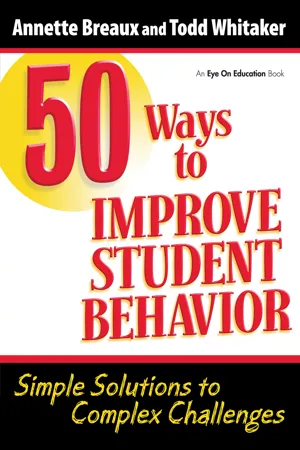
50 Ways to Improve Student Behavior
Simple Solutions to Complex Challenges
- 144 pages
- English
- ePUB (mobile friendly)
- Available on iOS & Android
50 Ways to Improve Student Behavior
Simple Solutions to Complex Challenges
About This Book
New from best-selling authors Annette Breaux and Todd Whitaker, 50 Ways to Improve Student Behavior: Simple Solutions to Complex Challenges is a must-read reference for teachers, both new and experienced!
In a lively and engaging style, Annette Breaux and Todd Whitaker share 50 simple, straightforward techniques for improving student behavior and increasing student cooperation, participation, and achievement. Each practical, well-defined strategy can be applied in classrooms of all grade levels and subjects. Strategies include:
- How to make students more responsible
- How to nip potential problems in the bud
- Learning what to overlook
- Establishing classroom rules and procedures
- Teaching in small bites (It makes students hungrier!)
As student behavior improves, so too will the quality of learning in your classroom. With this book, you can begin to introduce a host of new strategies into your teaching practice today!
Companion Study Guide Available
Frequently asked questions
Information
1
Meet and Greet
A Point to Ponder

Classroom Solution/Strategy

Bottom Line

Just what that gesture meant to me, she truly could not know
She did not know that she and only she made me feel wanted
That her smile got me through a time in life when I felt daunted
That life at home was way too tough for any kid to take
That her classroom was my refuge, that my happiness was fake
That for her I put my best foot forward, even when times were rough
That my smile was a façade to hide my pain, for I was tough
But even though she never knew, it meant so much to me
That there was one place in my life where someone wanted me
Wanted me to be there, wanted me to learn
Wanted to help me realize there were good things I could earn
For beyond the books and content, I learned that year that I
Was someone who, to someone, was worth a simple “Hi.”
2
A Letter of Introduction
A Point to Ponder

- Parents want to believe that their children are in the hands of competent, caring, trustworthy teachers.
- Children want to believe that their teachers are people who are excited to teach them and happy to have them in class.
- Parents who believe that you care about their children are much more likely to work cooperatively with you.
- Children who are in the classrooms of teachers they perceive as caring are more likely to exhibit better behavior than children who do not believe that their teachers care about them.
Classroom Solution/Strategy



Bottom Line

Table of contents
- Cover
- Title
- Copyright
- Meet the Authors
- What This Book Will Do for You
- Contents
- Preface
- 1 Meet and Greet
- 2 A Letter of Introduction
- 3 Tools for Rules and Procedures
- 4 Are You All Right?
- 5 Stay Near, Dear
- 6 Believe in Them!
- 7 Meting Out the Seating
- 8 Happy Notes to Parents
- 9 Their Own Notes to Parents
- 10 Make Them Responsible
- 11 Stress Success, Not Duress
- 12 Enthusiasm Breeds Enthusiasm
- 13 Pry for Why
- 14 A Laugh is Half
- 15 Student or Teaching Problem?
- 16 Learn What to Overlook
- 17 If You Sweat, They Win
- 18 Defuse the Bully
- 19 Hold Private Practice Sessions
- 20 Speak Awfully Softly
- 21 Teaching in Small Bites Makes Them Hungrier
- 22 Saving "Gotcha" for Behaving
- 23 Find the Gleaming and Redeeming
- 24 Join the Ranks of Thanks
- 25 Humiliation Breeds Retaliation
- 26 Beware the 90/10 Rule
- 27 We Care About Those Who Care About Us
- 28 As Nice, Polite, and Motivated as YOU?
- 29 Unmask the Mask
- 30 Don't Let the Mood Brood
- 31 Who's the Most Positive?
- 32 Become Interested in Their Interests
- 33 A Favor as a Lifesaver
- 34 Admit Your Mistakes
- 35 Seeing Eye to Eye
- 36 Bell-to-Bell Teaching
- 37 Smile, Smile, Smile!
- 38 Teaching with Urgency
- 39 Make it Doable and Chewable
- 40 Brag About Them to Others
- 41 The Diversion Excursion
- 42 Change the Way They Think
- 43 Nip It in the Bud
- 44 Discover the Beams of Their Dreams
- 45 Work that Body Language!
- 46 No Rest for the Weary
- 47 A Little Guilt Trip Goes a Long Way
- 48 Teach Them to Cope or They'll Create a Way!
- 49 Listen, Listen, Listen!
- 50 Only a Fool Loses His Cool
- Conclusion
- An Invitation for Your Comments